Different Types of Katana explained
When your interest in katana begins to grow, you might find yourself increasingly frustrating trying to understand the many types of Katana. Japanese sword terminology like Tachi, Uchigatana, wakizashi etc, keep bouncing in you head, information you found online are often misleading or imprecise, if you are having trouble understand the katana types, this article will break it down and make it easy for everyone to understand.
Table of Contents
- Types of Katana (Classified by length):
- Types of Katana (Classified by their period)
- Types of Katana (Classified by blade shape / geometry):
- Types of Katana (Classified by their sword making schools):
- Types of Japanese Sword (Classified by their cutting performance):
Understand the definition of "Katana"
First of all, we should understand there is a language barrier, for us non-Japanese speakers, if we truly understand the meaning of sword terminology in Japanese, it will make things a lot more clear.
Katana VS Nihonto
In Japanese, the word 'Katana' (刀) means a type of single-edged sword. However, in English, the term 'Katana' is often broadly referred to what is known in Japanese as 'Uchigatana' (打刀), or it is simply referred to as a 'Japanese sword.'
This caused a common conception among non-Japanese speakers, that when they see "Uchigatana", they will just call it "Katana" and recognize it as "Japanese swords". However, this conception isn't entirely correct.
In modern days, the correct term for Japanese sword is 'Nihonto' (日本刀), It breaks down into 'Nihon' (日本), meaning 'Japan,' and 'to' (刀), meaning 'sword,' hence 'Nihonto' literally translated to 'Japanese sword.'
But in ancient Japan, people just called bladed weapons "刀" (Katana, single edged swods) or "剣" (Ken, double edged swords). They are in Japan so they don't need to emphasize the "Japan" part for swords. 'Nihonto' only became widely used after the late Edo period, it was used to distinguish swords made in Japan, and swords imported from foreign countries.
Just like not all sparking wines can be called "Champagne", only blades made in Japan, following traditional sword making methods (folding and forging 折り返し鍛錬), and using Tamahagane (玉鋼) as material, can be called 'Nihonto' (Japanese sword, 日本刀).
Noted that we used "Blades" not "Swords", it's because broadly speaking, Nihonto refers to all sword / blades made in Japan, that even includes polearms like spear (yari).
So the conclusion is: Yes, calling an Uchigatana "katana" is still correct, because Uchigatana is a type of Katana. Same for Tachi, Wakizashi, Tanto etc. And for polearms like Yari, Naginata, calling them "Nihonto" will be more precise. We might still call swords made outside Japan "Japanese swords", just literally using it, it's certainly not approved by Japanese that any of these swords are "nihonto".
* It's worth to know that, all terms like "katana," "tachi," "nihonto," etc, they all specifically refer to the blade only (include the tang). This is different from the way we often think about swords in the West, where the handle, hand guard, and sheath are all considered parts of the sword. In Japanese, the fittings of a sword, such as the handle and sheath, are called "Koshirae 拵", and the Koshirae is a whole new different and interesting world.
Types of Japanese Sword (Classified by length):
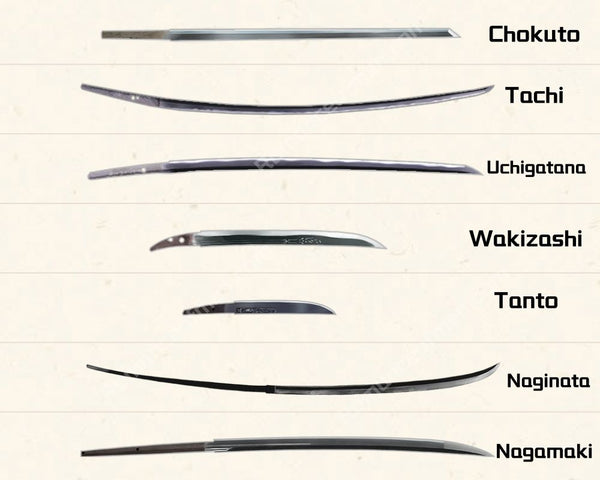
Chokuto 直刀:
“Chokuto" (直刀) refers to a straight swords without a curve, used before the middle of the Heian period, they are considered the prototype of Japanese swords. The Chokuto blade length usually is about 60 cm (about 23.6 inches), and the tang is about 12 cm (about 4.7 inches), makes the overall length about 70 cm (about 27.6 inches), a bit shorter than uchigatana or tachi.

In the Yayoi period, Japan got bronze and iron tools from other China and Korea. Then, Japan improved its iron-making skills and started making iron weapons. It's widely believed that Chokuto was invented during late Kofun period.

The shape of chokuto was heavily influenced by Chinese Dao, closely resembling Chinese weaponry from the Han through the Tang dynasties. The chokuto's straight blade makes it a good weapon for stabbing, making it useful in close fights. It wasn't as good at cutting as the katana, but it could still be used to slash. The ways to use the chokuto have been forgotten over time. There are no martial arts schools left that teach how to use the chokuto the way it was used back then.
Tachi 太刀:

"Tachi"太刀 refers to curved swords that began to be made around the end of the Heian period, tachi looks like the katana we are familiar with today, but actually Tachi is older than Uchigatana. Tachi is more curved like a bow, and the part of the blade close to the Nakago 茎 (the tang of the sword) has a strong curve, this shape called "Koshizori"腰反.
Tachi blade length are usually around 75.8 to 78.8 cm (29.8 to 31 inches) and were worn at the waist with the edge facing downwards, unlike the Uchigatana was worn through the obi (belt) with the edge facing up.

The prototype of the Tachi, called "Wantou"湾刀, began to be made from the early Heian period. The Wantou later became known as Tachi and, as they were more suitable for slashing opponents than Chokuto, were used until the Nanboku-cho period when horseback combat was the mainstream.
Depending on the size, Tachi can be divided into three types: "Odachi" (大太刀 large Tachi), Tachi, and "Kodachi" (小太刀 small Tachi).
"Odachi" or "Nodachi" are large Tachi swords over 90 cm (35 inches) in blade length. they were initially made for shrine offerings, but they were also used in battles. Usually only high-ranking samurai could own them. Their large size made them hard to carry, so they were often carried by the samurai's squire in battle. To use an Odachi, either the squire held the scabbard while the samurai drew the sword, or the squire drew it and handed it to the samurai.
"Kodachi" are Tachi with a blade length of less than 60 cm (24 inches) , made from the middle of the Kamakura period. They were not often used in actual combat, but were mainly used in ceremonies and celebrations. Their size is similar to "Wakizashi", so they are sometimes considered to be the same, but they are classified as Tachi due to their shape and curvature features.
Uchigatana 打刀:
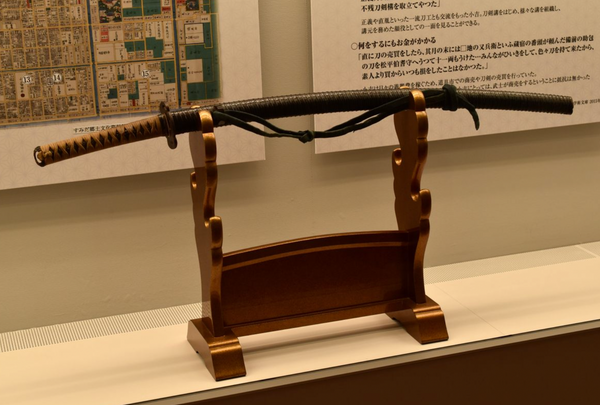
"Uchigatana"打刀 refers to swords that are generally called "Japanese swords”, which is the “katana” we know today. They have a blade length of over 60 cm (24 inches) and a characteristic shallow curve compare to Tachi. For the curve, it has the shape of "Sakizori"先反, where the part near the tip curves. Unlike Tachi, which are worn with the edge facing downwards, Uchigatana are typically worn with the edge facing upwards.
From the middle of the Heian period to the middle of the Muromachi period, Tachi was convenient for slashing while fighting on a horseback. In the Sengoku era at the end of the Muromachi period, the nature of battles changed from individual horseback combat to group infantry battles. As a result, Uchigatana, which were suitable for infantry combat, became mainstream.
Wakizashi 脇差:

A "wakizashi"脇差 is a Japanese sword with a blade length between 30cm / 12 inches and less than 60cm / 24 inches. The wakizashi emerged in the Muromachi period and was used as a sidearm along with tachi or uchigatana. The name Wakizashi (脇差) literally means "Side Inserted", implying the convenience of wearing this sword.
Like uchigatana, the blade of a wakizashi is worn facing up, but because it is shorter than an uchigatana, it was useful for close combat or in cramped spaces. It was also used as an emergency weapon in case the uchigatana was broken or chipped.
The wakizashi can be classified into three types according to its length: "large wakizashi", "medium wakizashi", and "small wakizashi”.

Large wakizashi (Ōwakizashi 大脇差) : Length ranges from about 54.5 cm (21.5 inches) to less than 60.6 cm (23.9 inches).
Medium wakizashi (Chu-wakizashi 中脇差) : Length ranges from about 40 cm (15.7 inches) to less than 54.5 cm (21.5 inches).
Small wakizashi (Ko-wakizashi 小脇差) :Length is less than 40 cm (15.7 inches).
During the Edo period, the samurai class was obligated to carry two swords, known as the Daisho set, which typically consisted of a katana and a wakizashi. The katana was the longer sword, while the wakizashi was the shorter one. This requirement led to an increased production of wakizashi during this era. Furthermore, even those not belonging to the samurai class, namely regular citizens, were permitted to carry only a wakizashi, further contributing to its widespread manufacture.
Tanto 短刀:

A "tantō"短刀 is a Japanese sword with a blade length of less than 30cm / 12 inches. It was also called a “koshigatana"腰刀 (means waist katana) because samurai wore it with the blade facing up at their waist. From the Kamakura period to the Muromachi period, it was used to decapitate enemies in hand-to-hand combat, tanto is good at stabbing enemy thought the gap of their samurai armor. but it was no longer used in battle by the Momoyama period.

In the Edo period and onwards, daughters of samurai families often carried tantō for self-defense. Because they often carried it in their bosom, it was called a “kaiken"懐剣 (dragger). The tantō can be mistaken for a wakizashi due to its size, but if the koshirae (mountings) has a bigger tsuba (guard), usually it's a wakizashi, if it doesn't have a tsuba and is an "aikuchi koshirae"合口拵 or "bikushi koshirae"匕首拵, it's a tantō.
Naginata 薙刀:

A "naginata"薙刀 is a long-handled bladed weapon specialized for "mowing down" an opponent. It originated in the Heian period and played a major role in many battles during the Nanboku-chō period. It was originally written as "long sword"長刀, but later, in order to distinguish it from the uchigatana which came to be called a long sword in contrast to the tantō, the character 薙刀 for naginata was adopted.
The length and shape of the naginata varied with the times. In the Kamakura period, the handle was about 120cm(47 inches) and the blade was about 90cm (35 inches), which was shorter compared to later naginata. On the other hand, the "ō-naginata" that appeared in the period of the Nanboku-chō had an even longer blade (about 190 cm 74 inches) and handle (about 150 cm 59 inches).
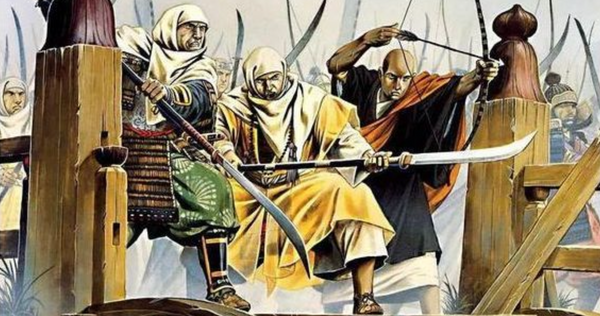
The naginata was popular as a main weapon in the period of the Nanboku-chō, but as the style of battle changed to group combat in the Sengoku period, there were incidents of accidentally injuring allies. Therefore, the "yari" (spear), another long-handled weapon, began to be used in battle, and the use of naginata gradually declined. After that, it was reshaped into a wakizashi called "naginata-naoshi 薙刀直し" and ended its role as a long-handled weapon.
Nagamaki 長巻:

"Nagamaki"長巻 is a type of sword similar to the naginata, but there is no clear definition for it. It's said to have evolved to make large swords easier to handle. Differences between nagamaki and naginata typically include size, curvature of the blade, presence of yokote (a line separating the blade from the kissaki), and differences in handle wrapping.
The blade length of a nagamaki is about 90cm (35 inches), and the handle length is from about 90cm to about 120cm (47 inches), so the blade and handle lengths are almost the same. Total length of a nagamaki is about 180 to 210 cm (about 71 to 83 inches)
Nagamaki VS Naginata
Typically, a naginata has a 60 cm blade with a much longer 270 cm handle, whereas a nagamaki features a blade and handle of almost equal lengths, around 90 to 120 cm each. Naginatas are known for their deep blade curvature, while nagamakis have shallower curves and a distinctive hamon line that doesn’t curve back towards the edge. Unlike naginatas, which generally have plain handles, nagamakis are characterized by handles wrapped in hemp or leather, which also contributes to their name. Additionally, nagamakis have a yokote line at the tip, a feature usually not found in naginatas.
The Nagamaki and Naginata were used differently. Both were good at sweeping and hurt the enemy, but the Naginata, with its longer handle than blade, was better for swinging around. The Nagamaki, however, had almost the same length for both handle and blade. This made it powerful, but it was harder to swing around like the Naginata.
Yari 槍:

A Yari 槍 is a spear with a long handle and a blade at the end. It's mainly used for stabbing and is one of the oldest and most basic weapons in world history.
In Japan, around the Yayoi period, spears evolved from an earlier weapon called a 'Hoko.' Over time, their shape and use changed.
There are two major parts of a Yari: the 'Ho 穂' which is the blade at the tip, and the shaft (柄). Depending on the type, the 'Ho' can be about 20 cm (7.8 inches) long in 'Nagaeyari' (長柄槍 long-handled spears) and about 60 cm (24 inches) in 'Omiyari' (大身槍spears with long blades). The shaft length varies, but it's usually around 4 to 6 meters (13 to 20 feet) for Nagaeyari and over 4 meters (13 feet) for Omiyari. There were even records of Nagaeyari with shaft up to 8 meters (26 feet) long.

Yari became popular in the late Sengoku period when battles shifted from cavalry to infantry. They replaced Naginatas and became widely used.
Hoko 矛:

"Hoko"矛 is a lance that has been used since ancient Japan, and it is considered the predecessor to yari and naginata. The most special characteristic of the hoko is that the blade is broad and double-edged. Compared to a yari, which is intended for stabbing and therefore has a sharp tip, the hoko is also intended for "cutting", so the tip of the blade has a rounded shape.
Hoko were usually held with both hands, but when used as a long stabbing spear, it was possible to hold a shield in the other hand. This means in battle, a Hoko could be used both for slicing and stabbing, depending on the situation.
Types of Japanese Sword (Classified by their period):

Over the past 1000 years, Japanese swords have evolved, influenced by many factors, and you will find Japanese swords in different periods, showing unique characteristics. Japanese swords (in this section, we mainly talk about Tachi, Uchigatana etc) can be classified by different periods:
Jokoto (上古刀): Swords made before Heian period. mainly chokuto. They are more of archaeological value than as art pieces. Technically speaking, Jokoto are not considered part of the traditional appreciation system of Japanese swords.
Koto (古刀): Swords made from the late Heian period to 1595 (Bunroku 4 文禄4年), the Kotō era encompasses several significant periods in Japanese history. During this time, katanas were developed and refined, particularly during the Kamakura period, known for the iconic tachi style. schools and styles of Japanese sword making, like the "Five Tradition schools (Gokaden 五箇伝)," were all developed in this period.
Shinto (新刀): Swords made from 1596 (Keichō 1 慶長元年) and continuing until 1771 (Meiwa 8 明和8年). Entering the Edo period, the forging process begin to standardized, many swordsmiths begin to use commercially produced steel, Therefore, the Jigane (地鉄) style of the majority of swords from the Shinto period shows a clear distinction from those of the Kotō period.
Shinshinto (新々刀): Swords made from 1772 (An'ei 1 安永元年) until the abolishment of swords (廃刀令) in 1876 (Meiji 9 明治9年). During this period, traditional Japanese sword-making skills hit an all-time low in history. The quality and artistic appeal of the products were poorer and more common than in any other era. With the advancement of time and the gradual replacement of cold weapons by firearms, along with the introduction of Western smelting and forging technologies, the traditional Japanese sword-making industry suffered a heavy blow. All these factors contributed to the decline of traditional sword-making techniques.
Gendaito (現代刀): Swords made from 1876 (Meiji 9 明治9年) and continuing to the present. It's important to note that "Shōwatō" (昭和刀, Syouwatou) is a different concept, typically, when referring to "Shōwatō," it doesn't just mean swords produced during the Shōwa period, but specifically refers to military swords (Guntō) produced by Japan during World War II.
Types of Japanese Sword (Classified by blade shape / geometry):
"造り" (zukuri) in the context of Japanese katanas refers to the specific style or method of construction of the sword's blade. It's a key aspect in traditional Japanese swordsmithing, describing how the blade is shaped, its cross-sectional geometry, and other distinctive features. Each "zukuri" style has unique characteristics that affect the sword's appearance, balance, weight, and cutting ability. The common types of blade geometries are:
Shinogi-zukuri (鎬造り, 本造り): This is the most common method for making Japanese swords, as seen in the mentioned photo. It's believed to have evolved from the Sakiha-zukuri style.
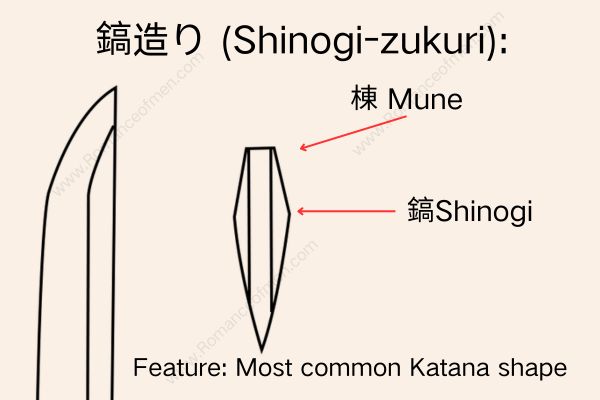
Hira-zukuri (平造り): Commonly used for short swords and wakizashi (small side swords). These swords don't have a ridge line and are often straight, like those made during the Kofun and Nara periods. Famous examples include the "Narikitsune" by the Kamakura period swordsmith Awataguchi Kuniyoshi and the Kasuga Taisha's diamond-shaped sword, which is a national treasure.

Kata-shinogi-zukuri (片鎬造り): One side of the blade is made in the Shinogi-zukuri style, and the other side is flat like in Hira-zukuri. An important cultural property by the Noshu smith Kanemoto from the Nanbokucho period is a notable example.
Sakiha-zukuri, Kata-sakiha-zukuri (切刃造り, 片切刃造り): This style features the ridge line closer to the edge. It dates back to the early Japanese sword period and includes famous swords like the "Sakiha-Sadamune." Echizen Yasutsugu and others made many copies of this style during the Keicho period.
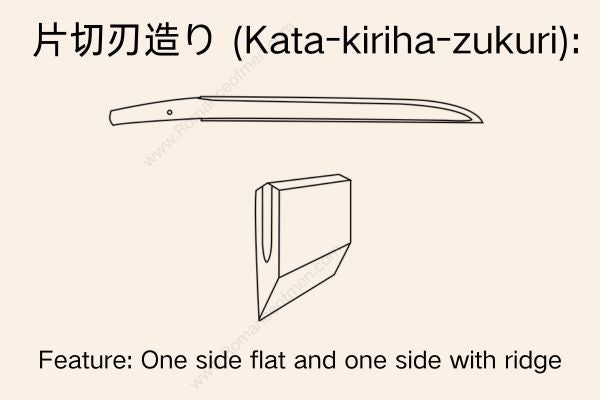
Kissaki-moroha-zukuri, Kokarasu-zukuri (切先双刃造り, 切先両刃造り, 小烏造り): The tip of the blade is double-edged, resembling a western sword. The Kokarasu-zukuri specifically refers to a sword where more than half of the blade is double-edged. The Kokarasu-maru sword is an existing example of this style.
Shobu-zukuri (菖蒲造り): This style resembles the shape of an iris leaf and started in the middle Kamakura period. It's mainly seen in wakizashi and short swords, but during the Muromachi period, some longer swords over 2 shaku were also made in this style by Bizen and Mino smiths.

Unokubi-zukuri (鵜の首造り): The blade narrows down like a cormorant's neck, with the back portion thinned out.
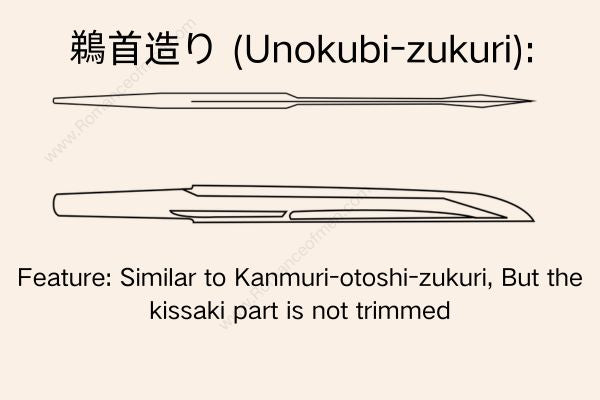
Kanmuriotoshi-zukuri (冠落造り): The back edge of the blade towards the tip is thinned out. It's commonly seen in short swords with naginata-hi (grooves).

Moroha-zukuri (両刃造り): The blade has edges on both sides with the tip pointing upwards. It appeared in the mid-Muromachi period, mostly in short swords around 7 sun long. Few long swords were also made in this style but they quickly fell out of favor.
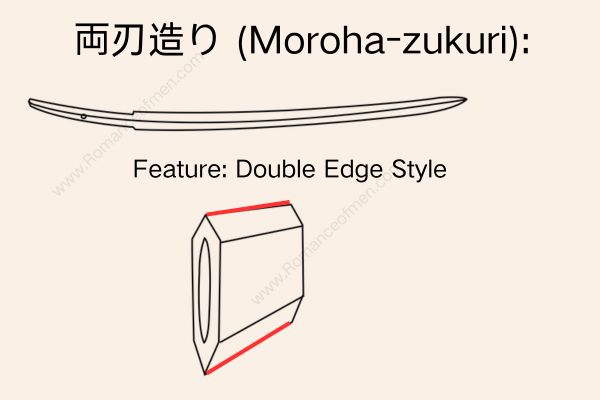
Osoraku-zukuri (おそらく造り): The position of the yokote (dividing line) is significantly closer to the hilt, and the tip occupies half to two-thirds of the blade. This style is mainly seen in short swords and wakizashi. The name's origin is debated, but it's likely derived from a short sword by the late Muromachi swordsmith Shimada Sukemune.

Nokogiri-ba-zukuri (鋸刃造り,): The back of the blade is serrated like a saw. It was used by the Awa naval forces both as a sword and a tool for cutting ropes and other naval equipment. The Awa region's "Awa swords" often feature this serrated blade and are still in existence today.
Types of Japanese Sword (Classified by their sword making schools):
We can also classify Japanese swords based on their swordsmithing schools. The five major swordsmithing schools are called "Gokaden" (五箇伝), each with its distinct style and techniques. They are:
Yamato-den (大和伝): Originating from Yamato Province.
Yamashiro-den (山城伝): Originating from Yamashiro Province.
Bizen-den (備前伝): Originating from Bizen Province.
Sōshū-den (相州伝): Originating from Sagami Province.
Mino-den (美濃伝): Originating from Mino Province.
Types of Japanese Sword (Classified by their cutting performance):
Katana with excellent cutting performance are called "Wazamono" (業物). This term was created by Yamada Asaemon (山田浅右衛門) from Edo period. He was a sword tester (tameshigiri), he tested over 20,000 swords, and ranked the best sword smiths based on their swords's cutting performance as follow:
Saijō Ōwazamono (最上大業物): Top 15 smiths who forged swords with the highest sharpness.
Ōwazamono (大業物): Next 21 smiths known for their superior sharpness.
Ryōwazamono (良業物): Following 58 smiths with notable sharpness.
Wazamono (業物): Next 93 smiths with commendable sharpness.
Additionally, 68 smiths who forged mixed categories of Ōwazamono, Ryōwazamono, and Wazamono are listed, totaling 255 smiths.
*Source of this article: Mainly from Touken world and wikipedia





















